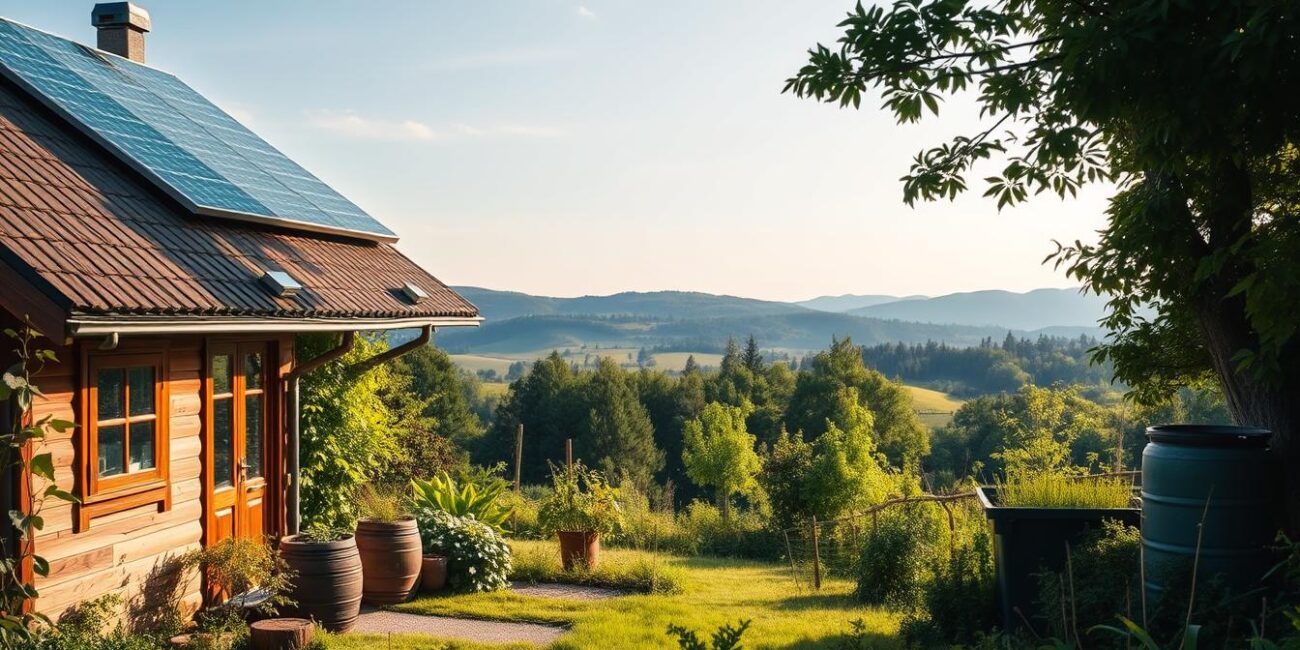What if every household in America made tiny shifts in daily routines? According to Dave Publicover, an AMC senior scientist, “Individual actions multiplied by millions can have major impact.” The numbers back this up—EPA data shows homes contribute 20-80% of emissions.
More families now adopt smarter ways to reduce waste and save energy. Simple swaps, like LED bulbs or reusable containers, add up fast. These steps protect the climate while cutting monthly bills.
This guide reveals 10 proven methods with measurable results. Each aligns with UN goals for a healthier world. Ready to see how your choices create ripples?
1. Reduce Waste with Simple Swaps
Small changes in daily routines can dramatically cut household waste. Every year, 335 million metric tons of plastic are produced globally, much of which ends up in landfills or oceans. Switching to reusable products and smarter disposal methods helps shrink this footprint.

Ditch Single-Use Plastics
Americans use 100 billion plastic bags annually—but solutions exist. Try these easy swaps:
- Carry reusable shopping bags (saves 1,500 plastic bags per person over a decade)
- Use stainless steel water bottles (prevents 167 plastic bottles per year)
- Choose glass or metal food containers instead of plastic wrap
Recycle and Upcycle Smartly
Recycling rules vary by city, but these tips work everywhere:
- Turn berry containers into herb planters
- Donate old clothes to textile recycling programs
- Drop plastic bags at grocery store collection bins
Paper, aluminum, and glass recycle efficiently—unlike plastic foam that never fully breaks down.
Transform Food Scraps
30-40% of the U.S. food supply gets wasted. Combat this by:
- Composting fruit peels and coffee grounds (cuts methane emissions)
- Freezing leftovers before they spoil
- Using vegetable scraps for homemade broth
Landfills take 25 years to decompose a leather shoe but just 6 weeks for an apple core. Choose where your waste goes wisely.
2. Adopt Sustainable Eating Habits
Your plate holds more power than you think—every bite impacts the planet. Food production drives 26% of global greenhouse gases, with livestock alone using 83% of farmland. Shifting how we eat can reduce carbon footprint significantly.

Opt for Plant-Based Meals
Science Magazine found plant-based diets cut land use by 76% and emissions by 73%. Compare that to livestock, which produces 250–500 liters of methane daily—a gas 25x stronger than CO2 for climate change.
Try these swaps:
- Replace beef with lentils (saves 1,800 gallons of water per pound)
- Choose oat milk over dairy (cuts emissions by 60%)
- Use mushrooms as meat substitutes in burgers
Buy Local and Seasonal
Local farms slash transport emissions. A tomato shipped 1,500 miles uses 10x the fuel of one from a farmers’ market. CSA programs (Community Supported Agriculture) guarantee fresh, low-mileage products.
Seasonal picks:
- Spring: Asparagus, strawberries
- Summer: Tomatoes, zucchini
- Fall: Apples, squash
Cut Food Waste Strategically
30% of U.S. food gets tossed. Rodale Institute notes composting scraps reduces landfill methane. Try these steps:
- Plan meals weekly to avoid overbuying
- Store herbs in water to extend freshness
- Use wilted veggies in soups or smoothies
AMC’s Greenleaf Hut even uses solar cookers to repurpose leftovers efficiently. Small changes protect the environment and your budget.
3. Conserve Energy at Home
Household energy use quietly shapes our environmental impact—here’s how to take control. PBS research shows homes generate 20–80% of U.S. emissions. Simple tweaks slash bills and reduce carbon footprints without sacrificing comfort.

Switch to LED Lighting
Traditional bulbs waste 90% of their energy as heat. LEDs use 75% less electricity and last 25x longer. A $5 LED bulb saves $75 over its lifespan—enough to power a TV for 1,000 hours.
Compare the savings:
- Incandescent: 60W, 1,200 lumens, lasts 1 year
- LED: 9W, 1,200 lumens, lasts 25 years
Unplug Idle Electronics
Vampire power drains $165/year per household. Devices like chargers and game consoles suck power even when off. Smart strips cut phantom loads by 50%:
- Plug TVs and sound systems into timed strips
- Use motion-sensing strips for home offices
- Unplug microwaves and coffee makers daily
Use Renewable Energy Sources
35 states now let homeowners buy renewable energy. Solar panels pay for themselves in 7–12 years. Texas’s Green Energy Program offers 100% wind power for $0.01/kWh extra.
Steps to transition:
- Conduct a DIY home energy audit (free kits at libraries)
- Compare state incentives at DSIREUSA.org
- Start with a 50% renewable opt-in plan
4. Save Water Daily
Freshwater scarcity affects every household, but solutions are simpler than you think. The U.S. Bureau of Reclamation notes only 1% of Earth’s water is drinkable, yet the average American home uses 300 gallons daily. Small changes protect this vital resource while cutting utility bills.

Fix Leaks Promptly
A dripping faucet wastes 3,000 gallons yearly—enough for 180 showers. Detect leaks with these steps:
- Check meter readings during a 2-hour no-water period
- Place food coloring in toilet tanks; color in bowls means leaks
- Inspect outdoor spigots for slow drips after rain
EPA estimates fixing leaks can reduce water use by 10%. That’s 30 gallons saved daily per home.
Opt for Shorter Showers
Showers account for 17% of indoor water use. Swap old showerheads for WaterSense-labeled models to save 2,700 gallons annually. Compare flow rates:
| Showerhead Type | Flow Rate (GPM) | Annual Savings |
|---|---|---|
| Standard | 2.5 | — |
| Low-Flow | 1.5 | 8,000 gallons |
Cut shower time by 2 minutes to reduce carbon footprint—water heating uses 18% of household energy.
Water Plants Wisely
Xeriscaping replaces thirsty lawns with drought-resistant plants like lavender or sedum. Key tips:
- Water before 9 AM to reduce evaporation
- Use mulch to retain soil moisture
- Collect rainwater in barrels for irrigation
This approach cuts outdoor water use by 50%, protecting the environment and your wallet.
5. Green Your Cleaning Routine
German wastewater carries 530K tons of chemicals—many from homes. Conventional cleaning products often contain toxins like ammonia and phosphates, which harm aquatic life and human health. Switching to safer options protects both your family and the environment.

Use Safer Cleaning Products
Look for EU Ecolabel or EPA Safer Choice certifications. These guarantee low toxicity and biodegradability. Avoid products with:
- Chlorine bleach (linked to respiratory issues)
- Synthetic fragrances (contain phthalates)
- Triclosan (disrupts hormones)
DIY Natural Cleaners
Simple ingredients tackle grime without chemicals. Try these recipes:
- All-purpose spray: 1 cup vinegar, 1 cup water, 10 drops lemon oil
- Scrub paste: ½ cup baking soda, 2 tbsp castile soap
Stop Microplastic Pollution
Laundry releases 35% of ocean microplastics. Reduce it with:
- Wool dryer balls (replace toxic dryer sheets)
- Guppyfriend washing bags (trap microfibers)
- Front-load washers (gentler on clothes)
AMC’s Leave No Trace principles apply at home too—choose items that leave waterways clean.
6. Embrace Sustainable Fashion
The fashion industry shapes our planet more than most realize—every wardrobe choice leaves a footprint. Fast fashion exports damage developing nations, while landfills overflow with 11 million tons of U.S. textile waste yearly. Smart swaps keep clothes in use longer and protect the environment.

Buy Secondhand Clothing
Thrifting reduces demand for new clothing production, which uses 93 billion cubic meters of water annually. Try these tips:
- Shop local consignment stores for quality items (saves 80% vs. retail)
- Use apps like ThredUp for curated secondhand products
- Host clothing swaps with friends to refresh wardrobes for free
Repair and Mend Fabrics
A ripped seam shouldn’t mean trash. Visible mending turns flaws into art while extending garment life. Start with:
- Darn socks with colorful yarn (saves 20 lbs of CO2 per pair)
- Patch jeans with fabric scraps (diverts 7 lbs of waste per household)
- Replace buttons instead of discarding shirts
Support Ethical Brands
Look for certifications like Fair Trade or B Corp. These brands prioritize:
- Organic cotton (uses 91% less water than conventional)
- Closed-loop recycling (e.g., Patagonia’s Worn Wear program)
- Living wages for workers (avoiding exploitative labor)
Rental platforms like Rent the Runway also cut clutter and save money. Small changes redefine style’s role in a healthier world.
7. Rethink Transportation
Transportation accounts for 29% of U.S. carbon emissions, but smarter choices can change that. Cars, planes, and buses rely heavily on fossil fuels, polluting air and accelerating climate shifts. Simple swaps—like biking or carpooling—cut costs and protect resources.
Carpool or Use Public Transit
Sharing rides slashes emissions. One bus replaces 40 cars, reducing traffic and carbon emissions. Compare options:
| Transport Type | CO2 per Mile | Annual Savings* |
|---|---|---|
| Solo car | 1.1 lbs | — |
| Carpool (4 people) | 0.3 lbs | $1,200 |
| Bus/Train | 0.2 lbs | $1,800 |
*Based on 12,000 miles/year. Many employers and AMC’s program offer subsidies for public transit.
Bike or Walk Short Distances
Trips under 2 miles? Skip the car. Cycling cuts carbon emissions to zero and improves air quality. Cities now add protected lanes and bike-share stations. Safety tips:
- Use lights and helmets (required in 22 states)
- Plan routes via apps like RideWithGPS
- Advocate for local infrastructure upgrades
Offset Travel Emissions
For unavoidable trips, balance the impact. AMC’s Maine Woods program lets you fund reforestation—$50 offsets 5,000 miles. Other steps:
- Book direct flights (takeoffs use 25% of fuel)
- Choose airlines with carbon-neutral pledges
- Explore staycations; a 500-mile drive emits 0.5 tons of CO2
Small shifts in transportation add up. Whether biking or buying offsets, every mile matters.
8. Create a Zero-Waste Home
A zero-waste home isn’t just a trend—it’s a practical shift. The average American throws away 4.9 pounds of trash daily. But with reusable products and creative reuse, that number can drop to zero.
Invest in Reusable Containers
Ditch single-use plastic for durable alternatives. Glass jars and stainless steel keep food fresh without waste. Compare options:
| Storage Type | Lifespan | Cost Over 5 Years |
|---|---|---|
| Plastic bags | 1 use | $120 |
| Glass jars | 10+ years | $40 |
Bulk stores like Zero Market offer discounts for bringing your own containers. This saves money and reduces packaging.
Choose Package-Free Products
Look for shops selling loose grains, soap bars, and shampoo refills. The Japanese mottainai philosophy—”waste nothing”—inspires global reuse programs. Top picks:
- Bamboo toothbrushes (compostable handles)
- Silk floss in glass jars
- Reusable beeswax wraps instead of paper or plastic
Repurpose Household Items
Turn old items into new tools. AMC’s hut crews reuse supplies for years. Try these projects:
- Convert wine corks into bulletin boards
- Use egg cartons for seed starters
- Donate broken appliances to repair cafés
Every repurposed item keeps 7.5 pounds of waste from landfills annually.
9. Support Environmental Causes
Policy changes and community action drive larger solutions for climate change. While individual habits matter, collective efforts—like voting, donating, and volunteering—multiply their impact. Today, $8.7 trillion flows into responsible investments, proving the power of aligned values.
Vote for Green Policies
Your ballot shapes the environment. Shareholder activism pushes corporations to ditch fossil fuels. Tools like OpenSecrets.org track politicians’ voting records. Key strategies:
- Support local carbon-tax initiatives (reduces emissions by 15–25%)
- Join advocacy groups like the Sierra Club for policy alerts
- Invest in green ETFs (e.g., iShares Global Clean Energy)
Donate to Conservation Efforts
Not all nonprofits deliver equal results. Compare these top-rated organizations:
| Nonprofit | Focus | Efficiency Score* |
|---|---|---|
| The Nature Conservancy | Land protection | 88/100 |
| 350.org | Climate activism | 92/100 |
*Charity Navigator ratings. CBS also funds urban health projects, like rooftop gardens in food deserts.
Volunteer Locally
Hands-on work bridges gaps. Platforms like VolunteerMatch connect you to:
- Beach cleanups (removes 5 lbs of trash per hour)
- Tree-planting drives (each tree absorbs 48 lbs of CO2 yearly)
- Citizen science apps (e.g., iNaturalist for biodiversity tracking)
AMC’s trail maintenance programs show how local action preserves the world we share.
10. Conclusion: Start Small, Think Big
Every small action adds up—your choices shape the future. Switching to LEDs, cutting water waste, or choosing plant-based meals might seem minor. But multiplied by millions, these steps slash carbon footprint and conserve resources.
Progress doesn’t stop at home. Support policies that expand renewable energy or join local cleanups. Tools like CBS’s carbon calculator show how tweaks add up. AMC scientists urge voting for leaders who prioritize the climate.
Innovation accelerates change. Solar tech and circular economies prove a healthier world is possible. Start today. Your home habits spark waves far beyond your doorstep.











